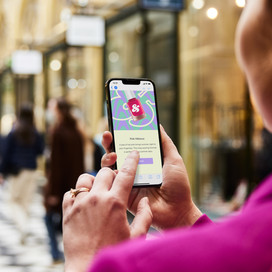Table of contents
As a business owner, you will encounter many customer types in your day-to-day activities – each will behave in different ways and request different things from your business.
Whether you want to know more about the different types of customers for customer service, or consumer familiarisation, understanding what motivates each type of customer can help give you a leg up on your competition. We’ve explored different types of customers below.
1. New Customers
Customers who are new to your business are going to ask questions about how things work, however, they may not know how to ask in the correct way. Many new customers may have questions that seem simple to you and your staff, but are justified for someone who’s never encountered what you do.
They may not know which product is right for them, or they may just want to learn more– every interaction with a new customer is crucial for your business. If you make it a positive one, then it is more likely they will become a returning customer.
Once a customer has purchased from you, it is much easier to retain them, as brand loyalty comes into play and a foundation of trust is built.
If you want to convert a new customer, customer service and guiding them through every step of the purchase process is key. You will have to be patient, but if you commit to helping them as much as possible then your rates of conversion may increase.
2. Impulse Customers
This type of customer can be irrational, quick thinking, and may not be money conscious. They will usually rush to purchase an item and they often miss the fine print. Due to the purchase being on impulse, if it is not what they desired, then they may come to your customer service team with a complaint.
Supermarkets and large retail stores target these customers by including small products in the checkout lanes. Online stores can mimic this by adding pop-ups during the checkout process. These pop-ups can include relevant products or complementary products to the one they are purchasing.
If the item in the pop up is relevant to your customers purchase intention, it can convert into a larger sale – ensure customers understand what they are purchasing to avoid negative reviews and customer service complaints.
Impulse customers will tend to purchase based on a product photo rather than the description. To target these customers having high-quality images on your website is important.
3. Disgruntled Customers
Upset customers can often be the most difficult to deal with, because no matter what you say or offer, they are likely to still be upset.
Having a strategy in place for disgruntled customers can be an effective strategy to manage these situations and retain the customers.
Ensure you are communicating with them in a calm and concise manner, let them be heard and say what they need to. Often the best medicine for an angry customer is an open ear.
Use Squares customer feedback software to learn more about how your customers are feeling and their interactions with your business. You can then make improvements based on this feedback.
Make sure your employees improve their empathy skills to help deal with frustrated customers – being able to put yourself in their shoes will help you solve their problems with limited consequences.
Disgruntled customers can convert into repeat customers if managed in the right way. If a customer is upset with your service or product, it may be appropriate to offer them a form of compensation. This may be a voucher or a discount. This can help position your business as respectful and build loyalty.
4. Loyal Customers
Loyal customers will be your favourite type of customer; however, they may expect priority service above other customers.
Converting loyal customers may be easier than new customers – they’ve supported your business for a long time, and have incredible brand loyalty and trust in your business. They can also be a great way to source organic marketing for your business – encourage them to share your business on their social media!
To ensure you keep converting loyal customers it is important to be proactive in your approach – discover issues before they arise and solve them promptly. It may be a good idea to introduce a loyalty program to ensure they feel valued and give them more of a reason to shop with you.
Square online offers a ready-to-go loyalty program that can be installed on-demand. Empower your customers to shop with you more by giving them deals and discounts on all their favourite items.
5. Tech-savvy Customers
Tech-savvy customers will always look for the best deal and will be able to quickly research competitor websites to ensure they are getting the best price.
Converting tech-savvy customers can be a challenge, they will often research their purchases and put thoughtful consideration into what they buy, and when. These customers are likely to be price-sensitive and that’s why they seek the best price.A tech-savvy customer may not want to pay for shipping. To convert this customer it may be appropriate to provide free shipping in order to capture extra revenue and increase your bottom line.
To ensure you convert these customers, offer all types of payment methods to take away the barriers to purchase. This can mean offering a buy now, pay later service like After Pay, along with traditional payment services such as PayPal or standard credit card processing. Square online offers a modern approach to taking payments online.
6. Research Based Customers
This type of customer can be one of the hardest to convert. They analyse your products against your competitors and look at the positives and negatives of purchasing from each retailer.
Converting them is possible, but your website and business presence must provide quality information, in the right place and at the right time. Consider adding social proof such as customer testimonials and case studies to your website.
You can also add features and competitor comparisons to outline what makes your business stand out against the competition. Ultimately, focus on your unique selling points (USP) and value propositions to ensure that you’re offering them the best product, whilst building trust between your business and the consumer.
7. Referral Customers
Referral customers are those who have been brought into the business by loyal customers. It is likely that they will understand your service to a high degree as their referrer would have discussed it with them prior to the purchase.
As loyal customers have referred these customers, their expectations may already be inflated, so it’s important to make their journey as frictionless as possible.
To ensure you convert this type of customer, have a clear referral onboarding plan to guide them through your business and provide them with a smooth experience. They may be interested in specific products or services, so your knowledge of your products will be critical in converting them.
If this customer has a negative experience with your business the loyal customer who referred them may also lose trust in your business. This is the worst-case scenario and must be avoided at all costs.
Understand what makes your business special
Regardless of customer type, consumers are likely to purchase from a business they trust. You can build trust in your business by promptly shipping items or effectively handling customer complaints. If you understand what makes your business special, then you can market to all types of customers.
![]()











